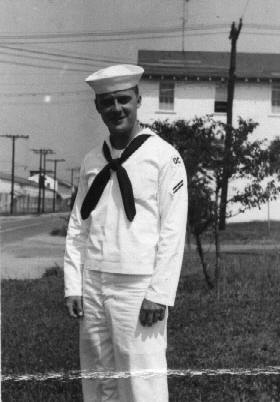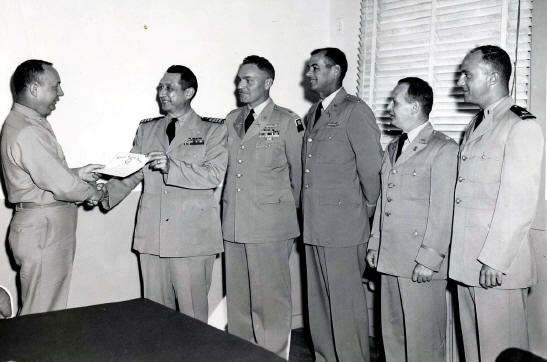NSA ... The Early Years
Commander John Murphy, USN Ret.
"Welcome to the NSA … you are going to be a codebreaker."
These were the first words I heard at NSA when I reported for duty in January 1957. I did not know what they meant, but I would soon learn. I was part of a group of Army, Navy, and Air Force officers who reported to NSA at that time. The nation had made a conscious decision to beef up its communications intelligence (COMINT) effort against the Soviet
bloc in the 1950s. A large, modern, headquarters began construction at Fort Meade, Maryland in 1952. A dream was about to become reality for those in the communications intelligence business. An Agency that "grew like topsy" after World War II was spread out in temporary sites in the Washington D.C. area. An organization Washington insiders liked to jokingly refer to as "No
Such Agency" was about to become much more visible.
 I finished college in 1955 and planned to become a lawyer. I had been accepted at Albany Law School in Albany, New York. Then I received what World War II vets called a "Greetings letter" from Uncle Sam. Whether I liked it or not, I was going into the military. The Selective
Service System that had been set up in World War II was still up and running. First for the Korean conflict and now, it appeared-for the new war… what everyone was calling the Cold War. Uncle Sam needed me for something or other.
I finished college in 1955 and planned to become a lawyer. I had been accepted at Albany Law School in Albany, New York. Then I received what World War II vets called a "Greetings letter" from Uncle Sam. Whether I liked it or not, I was going into the military. The Selective
Service System that had been set up in World War II was still up and running. First for the Korean conflict and now, it appeared-for the new war… what everyone was calling the Cold War. Uncle Sam needed me for something or other.
My older brother had just graduated from the U.S. Naval Academy and I decided to apply for the Navy’s Officer Candidate School in Newport, Rhode Island. To my surprise I was accepted almost immediately. I was ordered to report to the U.S. Naval Station at Newport, Rhode Island in June 1956 to enter the Navy Officer Candidate School, Class Nr. 28. After
four months of pretty rude treatment (e.g. early rising, marching, calisthenics, inspections (e.g. uniform, locker, bed making, showers and toilets etc.) studying naval warfare, jumping off 50’ towers into the sea, ship handling drills, navigation training, naval gun training etc. If we survived, we were declared ready to become "officers and gentlemen". Before we got too
cocky, our instructors reminded us, " You guys are so bad that it takes an Act of Congress to make you a gentleman."
Towards the end of OCS we started receiving "orders" to our future duty stations. I was hoping to receive orders to be the Commanding Officer of a destroyer at least. They looked so impressive as they sailed up the channel behind us into Narragansett Bay. Cruisers and aircraft carriers could come later. Most of my classmates were receiving assignments
to combatant ships or Naval Stations in the U.S. There was a small group of us however, that were told "You’re going to Washington D.C. for further assignment. They will tell you what your job is when you get there". This was all pretty disappointing for folks who had been "in processing" for over a year. Then, after commissioning, they added insult to injury by assigning us
to a three month Naval Communications "Officer Short Course" at Newport. We asked "Why are you sending us to a communications school?" Again, the answer was " You will find out when you get to D.C."
On New Year’s Eve 1956 seven of us showed up at an address in Washington D.C. that was in our orders- 3801 Nebraska Avenue, N.W. – right across from American University. We saw nothing that remotely resembled a military installation. After driving past a place that looked like a college two or three times- we stopped at a small parking lot with the
words "3801 Nebraska Ave. N.W." on it. We found a U.S. Marine guard in a small gatehouse. He welcomed us to the Naval Security Station, time-stamped our orders (to show we had reported for duty) and told us to come back the next day. Well at least we were there - wherever we were. Now maybe we were going to learn where we were going to be assigned.
During initial orientation I finally got to ask the question "what is it we do here?" I got an answer of sort. "We hope you’ll become a code breaker." I asked "why me?" The answer came back "You are a musician and recent studies have shown that two kinds of people make good code breakers-mathematicians and musicians!"
Well, there it was. At last, after 15 months of processing, I had broken the code! I was going to become a government codebreaker because I had played trumpet in the University of Notre Dame band! Welcome to the wonderful world of cryptology and codebreaking.
Assignment to NSA
I was briefly assigned to the Naval Security Group Headquarters at the Naval Security Station on Nebraska Ave. Just when I was starting to like it there; I was reassigned to the National Security Agency at one of its locations in the Washington D.C. area. I was assigned to "Tempo X" (Government Temporary Building X) at the site of the current RFK
Stadium in Washington D.C. It was a typical World War I temporary building. I was used to living in such buildings because that was all we had in Newport.
I learned that the major components of the new National Security Agency were located at a place called Arlington Hall Station or the Naval Security Station. I was to be assigned to the Office of Training at Arlington Hall Station in Virginia. Like the Naval Security Station, it was a former women’s college. A campus like setting with ivy covered brick
buildings hidden by rolling lawns, and mature shade trees. Shortly after arriving we were told: "Don’t get too used to this place, because sometime this year we will be moving to a new Headquarters building at Fort Meade. Maryland".
NSA felt more like a military agency than a civilian government agency. The agency was officially created in 1952. We were told that another agency known as the Armed Forces Security Agency (AFSA) had existed for a brief period, but did not work out for some reason. We were told that both Army and Navy communications intelligence organizations had
played a large role in Allied successes during World War II. That the NSA that I joined in 1957 was made up largely of Army Security Agency, Naval Security Group and newly created Air Force Security Service personnel. They, along with a sizable component of civilian NSA staff, made up a new agency that was bursting at the seams with enthusiasm. We would soon all be together
in one modern building.
In my early days at NSA, I had many conversations with men who worked in the Navy’s famed "Rooftop Gang". These men had their introduction to military cryptology in 1941 in an old World War I temporary building on Constitution Avenue. In a shack "on the rooftop". What enthusiasm and dedication to duty. These were real codebreakers! I walked in their
shadow. These were the men that actually broke the Japanese "Purple Code" that became a decisive factor in victories over the Japanese in the Battles of Coral Sea and Midway.
During the spring of 1957 I had the good fortune of getting to know some of the real heroes of World War II cryptology. Men such as Lambros Callimahos who worked in an office right next to me at Arlington Hall Station. Also, Captain John M. Lietwiler, USN ("Honest John") who commanded the Naval Security Group Detachment on Corregidor when it fell in
1942. After World War II Capt. Lietwiler was the first Commander of my parent command, the Naval Security Group. As a Lieutenant on Corregidor in April 1942 he commanded the 21-man Naval Security Group detachment known as the "Monkey Point Militia" that barely escaped alive aboard the submarine USS Seadragon.
